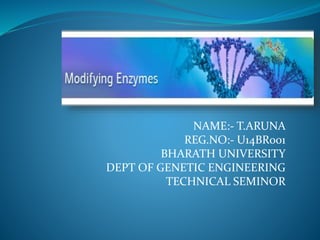
MODIFYING ENZYMES
- 1. NAME:- T.ARUNA REG.NO:- U14BR001 BHARATH UNIVERSITY DEPT OF GENETIC ENGINEERING TECHNICAL SEMINOR
- 2. Such manipulations of DNA are conducted by a toolkit of enzymes: restriction endonucleases are used as molecular scissors, DNA ligase functions to bond pieces of DNA together, and a variety of additional enzymes that modify DNA are used to facilitate the process.
- 3. DNA modifying enzymes Restriction enzymes and DNA ligases represent the cutting and joining functions in DNA manipulation. All other enzymes involved in genetic engineering fall under the broad category of enzymes known as DNA modifying enzymes. These enzymes are involved in the degradation, synthesis and alteration of the nucleic acids.
- 6. Nucleases Nuclease enzymes degrade nucleic acids by breaking the phosphodiester bond that holds the nucleotides together. Restriction enzymes are good examples of endonucleases, which cut within a DNA strand. A second group of nucleases, which degrade DNA from the termini of the molecule, are known as exonucleases.
- 7. Nucleases and its action
- 8. Polymerases Polymerase enzymes synthesise copies of nucleic acid molecules and are used in many genetic engineering procedures. When describing a polymerase enzyme, the terms ‘DNA- dependent’ or ‘RNA-dependent’ may be used to indicate the type of nucleic acid template that the enzyme uses. Thus, a DNA-dependent DNA polymerase copies DNA into DNA, an RNA-dependent DNA polymerase copies RNA into DNA, and a DNA-dependent RNA polymerase transcribes DNA into RNA.
- 9. DNA Polymerases Mesophilic and thermophilic DNA polymerases for different polymerization reactions, DNA end blunting and amplification, labeling and others. DNA Polymerase, Large Fragment DNA Polymerase I T4 DNA Polymerase T7 DNA Polymerase Terminal Transferase (TdT)
- 10. DNA Polymerase, Large Fragment •DNA Polymerase, Large Fragment, is a portion of DNA polymerase of Bacillus smithii, which catalyzes 5'=>3' synthesis of DNA and lacks 5'→3' and 3'→5' exonuclease activities. Highlights Thermophilic DNA polymerase with strong strand displacement activity
- 11. DNA Polymerase I DNA Polymerase I, a template-dependent DNA polymerase, catalyzes 5'→3' synthesis of DNA. The enzyme also exhibits 3'→5' exonuclease (proofreading) activity, 5'→3' exonuclease activity, and ribonuclease H activity.
- 12. Highlights Incorporates modified nucleotides Active in multiple buffers, including restriction enzyme, PCR, and RT buffers Applications DNA labeling Second-strand synthesis of cDNA in conjunction with RNaseH
- 13. T4 DNA Polymerase T4 DNA Polymerase, a template-dependent DNA polymerase, catalyzes 5'-3' synthesis from primed single-stranded DNA. The enzyme has a 3'-5' exonuclease activity, but lacks 5'-3' exonuclease activity.
- 14. T7 DNA Polymerase T7 DNA Polymerase, a template dependent DNA polymerase. It catalyzes DNA synthesis in the 5'=>3' direction. It is a highly processive DNA polymerase allowing continuous synthesis of long stretches of DNA.
- 15. Applications Purification of covalently closed circular DNA by removal of residual genomic DNA Primer extension reactions on long templates DNA 3'-end labeling Strand extensions in site-directed mutagenesis
- 16. Terminal Transferase (TdT) Protruding, recessed or blunt ended double or single stranded DNA molecules serve as a substrate for TdT. TdT is isolated and purified from an E. coli strain carrying the cloned terminal transferase gene from calf thymus.
- 17. DNA ligase DNA ligase is an important cellular enzyme, as its function is to repair broken phosphodiester bonds that may occur at random or as a consequence of DNA replication or recombination. It can therefore be thought of as molecular glue, which is used to stick pieces of DNA together.
- 18. Ligases Fast and efficient ligation of DNA and RNA. T4 DNA Ligase T4 RNA Ligase
- 19. T4 DNA Ligase The enzyme repairs single-strand nicks in duplex DNA, RNA, or DNA/RNA hybrids. It also joins DNA fragments with either cohesive or blunt termini, but has no activity on single-stranded nucleic acids. The T4 DNA Ligase requires ATP as a cofactor.
- 20. Applications Cloning of restriction enzyme generated DNA fragments Cloning of PCR products Joining of double-stranded oligonucleotide linkers or adaptors to DNA Site-directed mutagenesis
- 21. T4 RNA Ligase T4 RNA Ligase catalyzes the ATP-dependent intra- and intermolecular formation of phosphodiester bonds between 5'-phosphate and 3'-hydroxyl termini of oligonucleotides, single-stranded RNA and DNA. Applications Joining RNA to RNA Specific modifications of tRNAs Site-specific generation of composite primers for PCR
- 22. CONCLUSION: These are the modifying enzymes represent the cutting and joining functions in DNA manipulation and genetic engineering.
- 23. REFERENCES
Hinweis der Redaktion
- A mesophile is an organism that grows best in moderate temperature, neither too hot nor too cold, typically between 20 and 45 °C (68 and 113 °F).[1] The term is mainly applied tomicroorganisms. A thermophile is an organism — a type of extremophile — that thrives at relatively high temperatures, between 45 and 122 °C (113 and 252 °F).